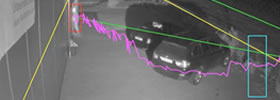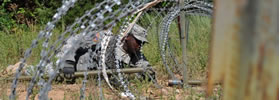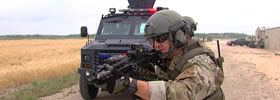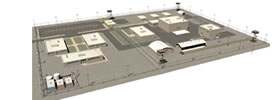
Physical Protection
There is an increasing global awareness that nuclear and radiological assets could be used for nefarious purposes. SNRI designs Physical Protection Systems (PPS) that integrate people, procedures, technologies, and Anshar's assets themselves into a single cohesive and comprehensive protection strategy. The PPS is designed to deter and detect malevolent acts such as theft, sabotage, and other illicit acts.
Much like safety systems that are installed to protect against natural disasters (such as earthquakes tornadoes, hurricanes, or floods) and abnormal environments (such as fire or electrical faults), security, or Physical Protection, systems are designed to protect against malicious human actions.
SNRI is constantly assessing and updating these systems and evaluating them against known risks. SNRI's assessments give our risk analysts a comprehensive view of the potential risks that exist at the facility.
Detection & Assessment

Detection and assessment are the first of three functions in a PPS. Detection and assessment equipment are needed to discover and correctly identify the actions of an adversary, both overt and covert.
SNRI just completed work with a vendor to install new advanced biometric readers at crucial points of entry to the site. The Readers use low-level infrared light, optics, and a CMOS camera to capture a three-dimensional image of the hand. Using advanced microprocessor technology, the Reader coverts the image to an eletronic template. It stores the template in a database along wiht the user's ID number.
To gain access, users use their ID badge and enter their personalized identification number (PIN). The Reader then prompts the user to place their hand in the platen. The system will compare the images and automatically permit access if the images are a match or alarm if the images are different.
SNRI has used local vendor, Cooperzino, to install and maintain the equipment.
Click here for more information from Cooperzino
Access Delay

Access delay serves the function of ensuring that SNRI's response force has adequate time to interrupt any potential adversary from completing their desired task after they have been detected inside SNRI grounds. SNRI institutes delay through fixed barriers, activated delay, and by responders. The amount of delay provided by SNRI's barrier depend on the characteristics of the barrier as well as the tools that the adversary has to penetrate them.
Response

The response force at SNRI detect illegal entry into the facility and prevent the adversary from completing their task. SNRI's response force includes on-site guards and off-site agencies including Utu's law enforcement and military personnel. SNRI's special response team's responsibility is to neutralize the adversary, by forcing capture or incapacitating the adversary.
About SNRI

SNRI was established in 1950 to serve as the primary nuclear energy research facility for the Republic of Anshar. The instititue houses various research, fuel fabrication, administrative, and plant support facilities.
The institute is located approximately 29km from Utu; Anshar's beautiful capital city.
contact us
Have questions? Need information? Looking for employment? SNRI is constantly seeking to engage with driven, innovative, and team oriented researchers, analysts, engineers. Contact us about potential research projects and joint opportunities!